Phosphorus and potassium nutrition
Phosphorus and potassium nutrition
Author: David W Lester (DAF Qld), Mike Bell (QAAFI/SAFS), Rick Graham (NSW DPI), Doug Sands (DAF Qld) and Greg Brooke (NSW DPI) | Date: 23 Feb 2016
Take home message
Positive grain yield increases with deep phosphorus (P) have been inconsistent across the northern region, with crop type (cereal or legume) and seasonal growing conditions affecting the outcome. Cereal crops (wheat, barley and sorghum) are responding (mainly) due to growing both a larger plant biomass and producing more yield. Chickpeas have not been as consistent, with some very good biomass results not always converting to higher yields, or in some cases no effects on either biomass or yield. Negative yield responses are rare in any species, provided soil is allowed to settle after deep tillage.
Potassium (K) responses have generally been additive to phosphorus, meaning we have to overcome the P limit before K can have an effect, but we have also seen evidence of P by K interactions where the application of P helps overcome a low K situation. Potassium responses are most widespread in Central Queensland, while in Southern Queensland and Northern New South Wales they have tended to be restricted to the upland slopes (predominantly) and some grey box soils where lower soil K supply levels have been measured. Soil testing is a good indicator of response (suggested 10-30 cm profile critical values of <0.2 cmol/kg), while chemical analyses of plant biomass have suggested chickpeas are a good indicator of low K soil supply.
Introduction
Cropping in the northern grains region revolves around the capture, storage and use of predominantly summer rainfall on relatively heavy soils to produce both winter (wheat, barley, chickpea, etc.) and summer (sorghum, maize, mungbean, etc.) crops. Native soil fertility was high for some soil types (primarily the Vertosols) but this has declined over time (Dalal and Probert 1997). As stored moisture is the principal plant water source, subsoil supplies of the largely immobile potassium (K) and phosphorus (P) are exploited and this may (will) not be obvious in surface soil nutrient monitoring. With little P or K fertiliser being used, the consequence is that exports of P and K are significant and primarily related to the grain yield of the crop. The removal of crop nutrients depends on the grain concentration and yield, with average rates of P removal being around 2.9-3.2 kg P/t of grain for wheat, sorghum and chickpea. K removal in chickpea (11.0 kg K/t) has been at least twice that for wheat (4.1 kg K/t) and sorghum (3.1 kg K/t). On average, cropped soils across all these northern regions contained 55% (±5%) of the exchangeable K reserves of the uncropped reference sites. This depletion is resulting in increasingly complex nutrient management decisions for growers, with results clearly confirming the impacts of fertility decline and nutrient removal (Bell et al. 2010, 2012).
The wetting and drying pattern of the soil in the northern region means that some of the subsoils have become largely depleted of nutrients, as the moist soil deeper in the profile is exploited by plant roots especially in winter crops where in-crop rainfall is lower. The topsoil is relatively enriched with K in particular, and so the soil testing protocols require adjustment to take account of stratification of nutrients as well as the supply of exchangeable K. Research has identified some strategies such as deep placement of K along with modified soil testing strategies to identify responsive sites. Subsoil testing for these immobile nutrients (P and cations) does not need to be done frequently as the rate of change is very slow.
In response to these challenges, the hypothesis was developed that relatively high rates of nutrients could be place in the subsoil (10-30 cm) to provide for several crop phases. The initial application would see some disturbance, with the duration of the responses uncertain. The experiments reported here aim to assess the long-term responses to P and K (and S), alone and in combination, when placed in the soil in bands at between 15 and 20 cm depth.
Results
Central Queensland
Our longest running experiments were set up with sponsorship from the International Plant Nutrition Institute (IPNI). Two nutrient addition experiments were established in which deep banding (~20 cm deep) was used to apply P (40 kg P/ha), K (200 kg K/ha) and S (30 kg S/ha) alone and in combination. The two sites – one at Capella and the other at Gindie – allowed multiple sequential crops to be monitored so medium term effects could be explored. The experiments were established to compare nutrient responses to a deep ripped treatment with no additional nutrients (control). Deep banding occurred in the winter fallow in 2011 and the bands were 50 cm apart.
The Capella site had four crops from 2012 until 2014-15 and demonstrated that P (at this site) was the principle limit, with K and occasionally S having additive effects after P was applied (Fig. 1). Applying P alone increased yield by 8% (or a cumulative 750 kg) but responses varied with crop and season. The initial crop grown after application of the treatments was chickpea and all P treatments (P, PK, PS, PKS) increased yield by at least 450 kg/ha. The following wheat crop in 2013 and chickpeas again in 2014 had some increases but where more influenced by P and K together than P on its own.
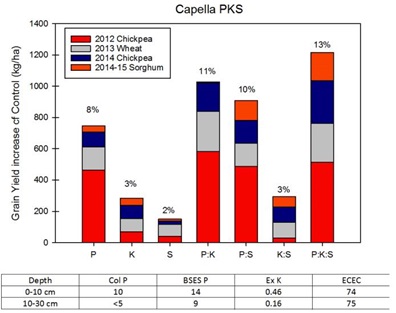
Figure 1. Increase in grain yield for four crops to nutrient application at Capella
The Gindie site was particularly interesting, as while the only nutrient limit at that site in the initial sorghum crop was P, the 2013 chickpea crop data suggested K availability was a greater limitation than P (14% response to P but 27% response to K), while the additive effects of (residual) P and K were substantial (51% grain yield increase). That trend continued into the 2014/15 sorghum crop.
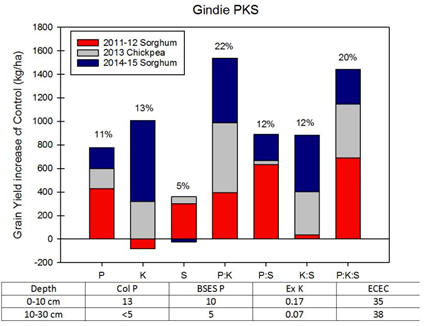
Figure 2. Increase in grain yield for four crops to nutrient application at Gindie
The biomass response to P and K was substantial with chickpea at the Gindie site in 2013 (Fig. 3). The dry matter increase at maturity with PK or PKS treatments was 68% over control (1600 kg/ha). This increase did translate to a yield increase of 530 kg/ha averaged on the same treatments (Fig. 2), but has not always been recorded in crops in Southern Queensland.
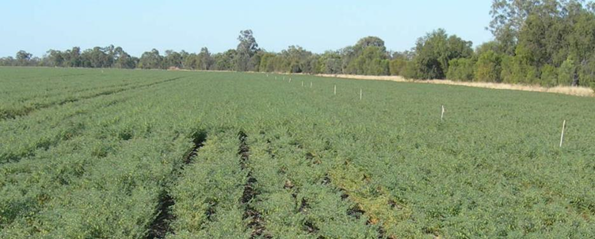
Figure 3. Gindie chickpea showing growth in the control treatment (foreground) and with deep PK (background) at 30 August 2013
These two initial PKS sites established that P and K appeared most limiting, and encouraged further investigation with seven rate response sites in CQ (as part of UQ00063) for the nutrients to evaluate increasing rates of addition. Five of these have had their first season of data and two (including the site at Dysart in Fig. 4) are approaching their third crop.
The sorghum responses at Dysart have been consistent between years, and confirm the hierarchy of P (first) and K (second) limitations. The addition of Farmer Reference treatments (FR - existing local management) in these studies has allowed the deep ripping and basal nutrient (N, Zn) effects (mainly in the initial crop) to be quantified. Relative to current practice, the deep ripping and application of P (the S had no significant impact) increased yields by 16% (900 kg/ha) while the further addition of at least 50 kg K/ha raised that response to 25% (>1400 kg/ha) over the two sorghum crop years. Interestingly, the deep ripped treatments have typically accumulated more P and K – probably due to more thorough root exploitation of the soil profile.
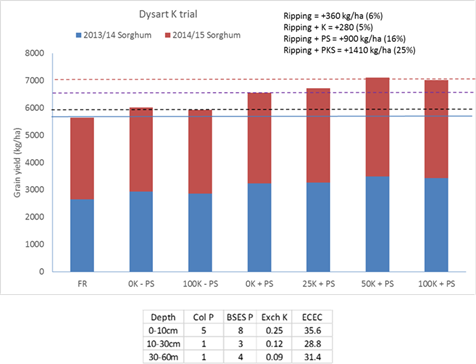
Figure 4. Grain yield response in a potassium rate trial with/without a background PS application in successive sorghum crops grown near Dysart
Similar responses have been recorded at other sites. For example, the initial crop year at Moura in 2015 (chickpeas), with the addition of P (and basal S, Zn) increasing yields by 20% (an additional 350 kg/ha) relative to the FR, while the addition of a further 100 kg K/ha increased the yield advantage to 30% (. an additional 530 kg/ha).
Results for the remaining trials are currently being collated and chemical analysis of the dry matter samples undertaken to assess nutrient recovery.
While still in the early stages of experimentation, the results from Central Queensland are encouraging with cumulative increases in grain yield of around 1000 kg/ha over three or four crops. Single year increases of nearly 500 kg have been measured in chickpea, with combinations of P and K together at a number of sites.
Southern Queensland
The P and K work in Southern Queensland has consisted of a cluster of 6 sites on a line roughly from Goondiwindi to Condamine, a site just east of Goondiwindi, 4 sites east of Warra and one north-west of Wondai in the South Burnett.
Cumulative responses to deep fertiliser application on the western downs sites (exclusively deep P, as K status has been adequate), have been poor, but starter P applications at relatively low rates have proven to be very effective. As an example, a site at Inglestone has grown three crops (Wheat - Chickpea – Chickpea) from 2013 to 2015 (Fig. 5). With no starter application, cumulative grain yield was reduced by nearly 1000 kg/ha, representing a 15% reduction in grain produced. None of the deep P treatments have demonstrated any effect above that of the basal N, S and Zn application and deep tillage (the 0 P treatments). Whilst unexpected given the low soil P status, this result has been consistent with crop P uptake data showing as much or more P uptake from the low rate of starter P as that from the deep P bands. Over the 3 crop seasons only an additional 5.3 kg P/ha was taken up in crop biomass from the highest deep P rates, and almost all of this was removed in grain.
The poor acquisition of deep P and the relatively strong response to low rates of starter (especially in chickpeas) raises questions around the most effective P application strategy in these drier western environments.
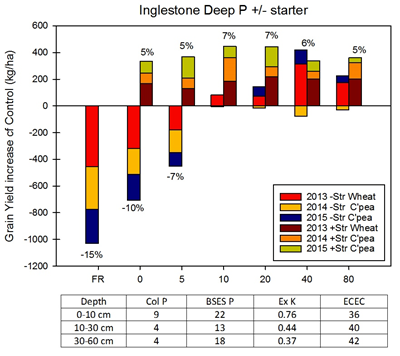
Figure 5. Cumulative difference in grain yield versus district practice with deep placed P with three winter crops grown at Inglestone, Qld from 2013 to 2015
Contrasting the results from Inglestone are those from Wondalli, east of Goondiwindi (Fig. 6). The negative effects of having no starter application were similar to Inglestone (13% or 750 kg/ha yield reduction) with the wheat crop accounting for basically all the loss. However, in the presence of starter there was a nearly linear response to increasing rates of deep P, with 10, 20, 30 and 60 kg P/ha delivering 200, 760, 900 and 1500 kg/ha extra grain in the 2 crop seasons, respectively. This site was characterised by higher yields and average crop P uptake, but the greater P demand only resulted in slightly higher deep P uptake (~7.5 kg P/ha) but with slightly more than half that uptake removed in grain.
The differences in yield responses and crop P acquisition from deep bands between these contrasting sites may have been influenced by factors such as the timeliness of in-crop rainfall and resulting root activity relative to key physiological processes, general water use by crops and (in winter crops) the rate of temperature increase during reproductive development.
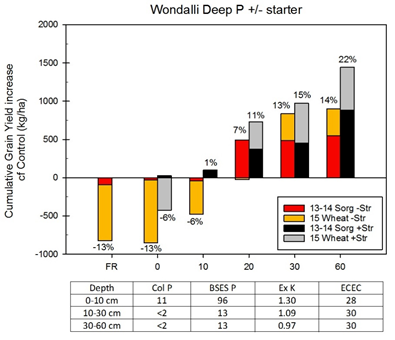
Figure 6. Cumulative difference in grain yield versus district practice with deep placed P with one summer and one winter crop at Wondalli, Qld from 2013-14 and 2015
Upland slope soils in the eastern areas of southern Queensland have been responding well to potassium application (Fig. 7), even the cereal crops which typically have a lower potassium demand than pulse species. In this instance the ‘0K Nil P’ treatment is the benchmark against which responses are assessed. Both crops showed improvements from the addition of both P and K (an additional 1350 kg/ha grain produced), although the initial sorghum crop response (second crop grown as double crop from wheat) suggested that the primary limitation at the site was K.
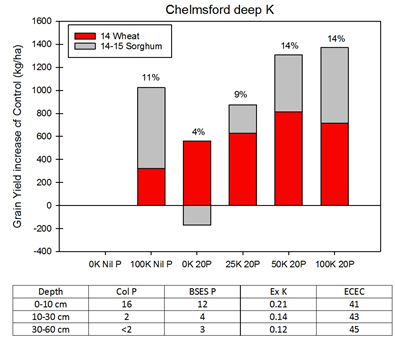
Figure 7. Cumulative grain yield responses in a potassium rate trial with/without a background P application from sorghum in 2014-15 and wheat in 2015 at Chelmsford, Qld
Northern New South Wales
NSW deep placed nutrition sites cover the North West plains, North West slopes, Liverpool Plains and more recently the Central West, although many of these sites haven’t had the longevity of the equivalent sites in Queensland. An exception to this however, is the site on the NW slopes at Terry Hie Hie, which was established prior to the 2013 winter season and has now grown 3 crops (wheat, long fallow to sorghum, double crop to chickpeas). Soil test P and K profiles were similar to many other locations. While harvest of the initial wheat crop was lost to an eager contract harvester the subsequent data show some similarity to that from the site at Wondalli (Fig. 6) there was a near linear response to increasing rates of deep P – particularly in the presence of starter P. This response was dominated by the long fallow sorghum crop, and this was particularly interesting given that grain protein contents indicated low available N (7.9% in the FR and 0P treatments, decreasing to only 7.0% with high P). The response to deep P may have been even greater if more N was available. Double cropping the chickpea into the sorghum would have meant that AMF levels should have been very good and helped in the recovery of P from the soil.
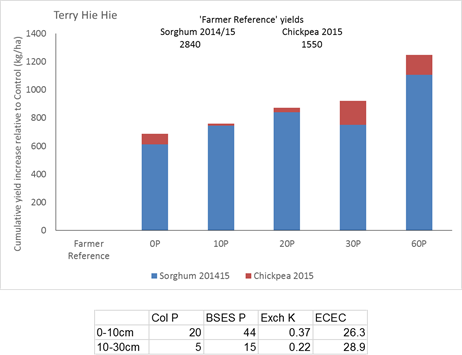
Figure 8. Cumulative grain yield responses to deep P rates applied near Terry Hie Hie in Jan 2013. Yields from the initial wheat crop were unfortunately not recorded but data is shown for the subsequent 2014/15 sorghum and 2015 chickpea crops. No starter P was used in the summer sorghum, while starter effects were not significant in chickpea, averages of with and without starter treatments are presented
Most other P sites have only a single year of crop data so far, and results from these sites have been mixed. For example, a site at Garah (Barley in 2015) showed no yield response to either starter P or a range in rates of additional P applied either shallow (5cm) or deep (20cm), despite some obvious biomass differences at anthesis. However the P status of that site was such that starter P responses would not have been expected (Colwell P in the 0-10cm layer was 42 mg/kg) and the P status of the 10-30cm was in the grey area where responses are uncertain (i.e. Colwell P was 6 mg/kg and BSES P was 61 mg/kg). Analysis of biomass to determine crop P uptake has not yet been completed.
The sites in the Central West were contrasting soil types to most other locations (a red Chromosol at Nyngan and a brown Chromosol at Gilgandra) and had deep (20cm) or shallow (5cm) P bands applied just prior to planting. Luckily, post sowing rainfall allowed reasonable establishment at both sites, however the late deep tillage did have some negative impacts at both sites. This was most evident at Nyngan, where treatments without deep tillage recorded 16% better crop establishment and produced 17% more biomass and 18% more yield, regardless of P rate. The negative impacts of late deep tillage were not as evident in crop establishment at Gilgandra, but shallow tilled treatments still produced >10% more grain than deep tilled treatments, irrespective of P rate – possibly due to impacts on profile moisture reserves. The inclusion of an untilled ‘Farmer Reference’ treatment would have allowed a better estimate of the negative impacts of tillage on crop yield potential in this initial season, but the disturbance effects on starting soil moisture should not feature in subsequent seasons.
Yields of the Control treatment (starter P with no additional P application) were higher at Gilgandra (3850 kg/ha) than Nyngan (2450), and these higher yield potentials coincided with a greater P demand and more consistent response to additional P application. Both sites showed similar yield losses without starter P application (~600 kg/ha, or 16% to 25% of the Control yields for Gilgandra and Nyngan, respectively), with this reliance on starter P reducing as P rates (shallow or deep) increased. However in the presence of starter P it was only at the higher yielding Gilgandra site that additional P applications produced consistent yield increases, with a maximum of 10% (~400 kg/ha) extra grain produced from the 80 kg/ha P applied. The residual benefits of these additional P applications at different placement depths will be followed in subsequent crops – without the confounding effects of the soil disturbance from the deep P placement.
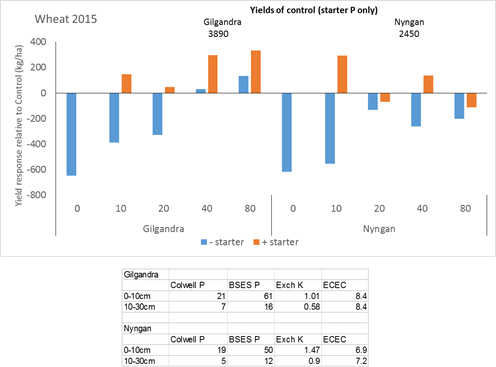
Figure 9. Grain yields from 2015 wheat crops at Nyngan and Gilgandra in response to both starter P and additional P at various rates placed either shallow (5cm) or deep (20cm). Data are shown for the average of the 2 application depths
There has been limited exploration of K responsive sites in NSW at this stage, with the exception of another site on the NW slopes near Biniguy where K responses were followed in successive dryland cotton and wheat crops. There were significant responses in seed cotton yield in an extremely dry year in 2013/14, where the reference yields were only 460 kg/ha of seed cotton (fractionally more than 1 bale/ha). Application of 50 or 100 kg K/ha increased yields by >50%, and there was a suggestion of an additive effect of deep P with K. However there was no evidence of any effects of P or K in the following 2015 wheat crop, where the Reference yields were 4050 kg/ha. The relative importance of subsoil K supplies in the very dry (2013/14 summer) compared to the quite favourable (2015) season would have been marked, in addition to the reported higher critical soil K requirements in cotton than cereal grains. This site also had higher exchangeable K than the Chelmsford site (Fig 7) where significant K responses were recorded in both wheat and sorghum, with the largest differences in the 0-10cm layer, which would have been relatively accessible in the wet 2015 season.
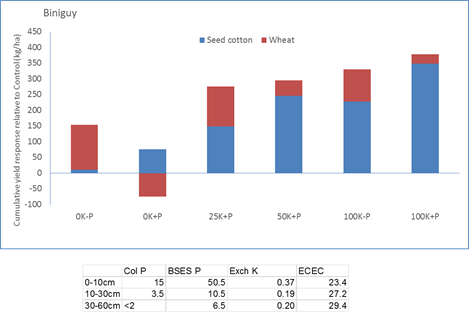
Figure 10. Seed cotton (2013/14) and wheat (2015) yield responses to banded applications of K, in the presence or absence of deep P bands, in a site at Biniguy. Data is presented as the yield response relative to the Farmer Reference treatment (no disturbance or deep nutrient placement)
Results from other 2015 winter sites on the NW plains confirm benefits of starter application, but under some excellent growing conditions have not shown any additional yield response to deep placed P.
General discussion
Current deep placement research is demonstrating mixed outcomes, from consistently good responses in some districts e.g. Central Queensland, to more mixed results in southern Queensland and Northern New South Wales. Part of this divergence in responses is related to the widespread low P and K at most sites in Central Queensland, compared to the more variable but generally slightly higher background fertility in other regions. However other factors affecting the utilization of deep fertilizer bands are also at play. We clearly require a better understanding of how plant roots acquire P (and K) from bands in drier environments (where lower soil moisture contents restrict diffusive supply), as well as how improved nutrient supply interacts with crop physiological processes determining harvestable yields under a range of seasonal growing conditions. This information will allow a clearer understanding of where deep placement will produce the most reliable yield responses.
Where evaluated, responses to starter fertiliser are demonstrable in most of our research sites where Colwell P in the top 10cm is low. Growers are encouraged to continue using starter P fertilisers at rates appropriate for the crop row spacing and soil moisture conditions at sowing. Applying small amounts of P in the seed row at sowing is offering excellent utilisation of the nutrient by the emerging crop.
Yield increases with deep P application are predicated on a crops’ ability to access and utilise the nutrient in the band, and the structure of different crop root systems is clearly important in this regard. Winter and summer grass crops with fibrous root systems appear to make better use of the bands currently applied on 50 cm row distances, with more consistent increases in dry matter, grain yield and P uptake being measured at responsive sites. The more coarsely rooted chickpea crop has not been able to consistently demonstrate the same ability to utilise nutrient applied on this row spacing – although when responses are recorded they can provide good financial returns. The limited ability of chickpeas to proliferate roots in and around a P band shown by Guppy et al. (GRDC Updates 2014) is likely to be contributing to this, so proximity of crop rows and fertilizer bands may be more important in chickpeas than the grain crops. Further work is required to confirm this.
Soil testing for K is proving a reasonable indictor of soil supply, but we do not as yet have reliable links between soil K test results and likely yield responses. However reasonable individual and cumulative yield increases in response to applications of K at rates of 50 or 100 kg K/ha at depth, generally in combination with a P source, are being measured on some low soil test K sites.
References
Dalal RC, Probert ME (1997). Soil nutrient depletion. In 'Sustainable crop production in the subtropics: an Australian perspective'. (Eds AL Clarke and PB Wylie). (Queensland Department of Primary Industries: Brisbane, QLD.)
Bell MJ, Moody PW, Klepper K, Lawrence DN (2010). The challenge to sustainability of broadacre grain cropping systems on clay soils in northern Australia. In 'Proceedings of the 19th World Congress of Soil Science; Soil Solutions for a Changing World. ‘(Eds. RJ Gilkes and N Prakongkep) pp. 302-305. (IUSS: Brisbane, Australia)
Bell MJ, Lester DW (2012). Multiple nutrient deficiencies in northern grains cropping – latest results and management responses for system profitability. In 'Grains Research Updates.' (GRDC: Goondiwindi)
Acknowledgements
The research undertaken as part of this project is made possible by the significant contributions of growers through both trial cooperation and the support of the GRDC, the author would like to thank them for their continued support.
The willing cooperation of many growers in hosting experiments over multiple seasons is gratefully acknowledged and the authors acknowledge the field and technical support provided by their respective project teams across Qld and NSW.
Contact details
David W. Lester
Queensland Department of Agriculture and Fisheries
PO Box 2282, Toowoomba Q 4350
Ph: 0428 100 538
Email: david.lester@daf.qld.gov.au
Mike Bell
The University of Queensland
School of Agriculture and Food Sciences, Gatton Q 4343
Ph: 0429 600 730
Email: m.bell4@uq.edu.au
New South Wales Department of Primary Industries
Tamworth, NSW 2340
Ph: 0428 264 971
Email: ricky.graham@dpi.nsw.gov.au
GRDC Project Code: UQ00063,
